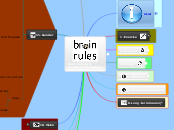Book Summary
by Johan D'Haeseleer
7. Sleep
try sleeping on it
promote naps
match chronotypes
sleep loss = brain drain
go ahead sleep on it
Mendeleyev
napping in the free world
26' nap
NASA pilots performance 34% up
napping is normal
Siesta
sleep need
we don't know
varies
puberty
pregnancy
gender
age
lark or owl?
late chronotype
sleep debt
spectrum in between
hummingbirds
early chronotype
internal clocks
two opposing forces
homeostatic sleep drive
circadian arousal system
you cal this rest?
brain = resting
non-REM sleep
deepest part
brain = active
no sleep = malfunction
loss of sleep hurts
motor dexterity
logical reasoning
quantative skills
mood
executive function
attention
sleep is perhaps necessary to learn
8. Stress
power to the workforce
free child care
free family consulting
Teach parents first
No firewall
work productivity
personal issues
stress at work
condition home life
balance between
boredom
stimulation
Types of stress
stress in the home
Tipping Point
Allostatis
Villain/Hero
Stress hurts people
Stress hurts learning
Chronic exposure can => depression
Cortisol
Motley Crue
from sniffles to forgetfulness
flooding the system
immediate
designed
short period
survival
Hormone
elite strike force
cortisol
overall effect
fight
flight
terror and titillation
difficult to detect stress
3. Not feel in control of the stressor
2. Stressor is perceived as aversive
1. Aroused physiological response
3 part definition
difference in kind of stress
boost
hurt
learned helplessness
Gamel
no way out
9. Sensory Integration
smells at work
sensory branding
proust effect
emotions
affect motivations
multi sensory school lessons
Nosing it out
odors
help retrieve the emotional detail
learning link
rules for the rest of us
Modality principle
animation and on-screen text
animation and narration
coherence principle
extraneous material excluded
extraneous material included
spatial contiguity principle
words pictures together
temporal contiguity principle
words pictures apart
words pictures simultaneously
multimedia principle
words alone
word and pictures
supra additive integration
multi sensory presentations
survival by teamwork
stimulate more of the senses
bottoms up,
tops down
Saturday night fever
processed simultaneously
amount of info
senses work together
energetic
touch
smell
taste
sound
sight
10. Vision
toss your traditional ppt
teachers should use computer animations
pictures grab attention
worth a thousand words
pictorial superiority effect
pictures beat text
we see with our brains
example wine tasters
11. Gender
use gender teams in the workplace
different gender arrangements in the classroom
get the fact straight on emotions
gender difference in processing information
emotions are useful
nature or nurture
battle of the sexes
into adulthood
negotiating status
girls
let's do this
boys
do this
cementing relationships
boys cooperate
through competition
verbal communications
dealing with traumatic situations
Female
remember the details
acute stress handled different
Male
gist of the experience
first hints
is bigger better
the x-factor
starts with conception
12. Exploration
college of education that studies the brain
analyze the success of medical schools
consistent exposure to practical research programs
consistent exposure to people who operate in the real world
consistent exposure to the real world
from dinosaurs to atheism
discovery brings joy
fire hose of curiosity
monkey see, monkey do
tongue testing
breaking stuff
desire to explore
active testing through
conclusion
experiment
hypothesis
observation
babies are the model
6. Long-term memory
days and weeks
minutes and hours
25' modules
3 times same subject a day
classroom and boardroom
many types of forgetting
allows to prioritize
memories on the move
nomadic memory
repetition
forgetting curves
remediate
chatty marriage
sparking interest
long term potentiation
space out the input
elaborative rehearsal
immediately after
occurrence
thinking talking
maintenance rehearsal
mind the gap
consolidation
reconsolidation
episodic memory
autobiographical memory
semantic memory
working memory
executive
visual
auditory
5. Short-term memory
Ideas
familiar settings
environment
more elaborate
same conditions
compelling introductions
be vulnerable
info remembered
contextual
meaningful
elaborate
Cracking the code
initial encoding
replicating the conditions
memory trace
same parts
processed
perceived
encoding in its initial moment
more details > greater learning
the stronger the memory
Memory&mumbo jumbo
automatic or stick shift
the electric slide
electrical language of the brain
outside stimulus
effortful processing
structural encoding
phonemic encoding
semantic encoding
Automatic
sliced and diced
forgetting
retrieving
storing
encoding
where memories go
at least 2 sorts
memories that don't
memories that involve conscious awareness
?
retrieval
storage
active remembering
more than Darwinian Chess Piece
rain man
4. Attention
do 1 thing at a time
example
cell phone car
always on line = always distracted
sequential processor
bait the hook
hook between modules
hooks needs to be relevant
trigger an emotion
lecture design 10 minute segments
red alert
behavioral characteristics
your brain needs a break
not capable of multitasking
Meaning before detail
Emotion
Have I seen it before
Can I mate with it?
Can I eat it?
executive network
orienting network
alerting and arousal network
memory
culture
previous experience
you loose attention after 10 minutes
medium interest
3. Wiring
customized instruction
smaller class size
mapping the brain
we all have a
Jennifer Aniston
neuron
School system ignores that brain are wired differently
use it
not education
amazon
what you learn changes your brain
7 billion sorts of intelligence
2. Survival
meet your brain
three brains
Human brain
Paleomammalian brain
Lizard brain
functions 4F
reproductive behavior
fleeing
feeding
fighting
great anti-brain environment
cubicle
classroom
relationships helped us survive
jungle
school
work
strongest brain survive
create alliances
start teamwork
learn from mistakes
solve problems
brain = survival organ
you adapt to variation itself
in nearly constant motion
in unstable outdoor environment
1. Exercise
study
one active
sedentary
brain evolved under motion
ideas
treadmills in classrooms and cubicles
recess twice a day
we can make a comeback
Survival of the fittest
are cognitive blessings of exercise only for the elderly?
can exercise treat disorders
What's the bad news?
Can you turn Jim into Frank?
Is there a factor that predicts how well you will age?
About
mind map
map =/= book
images
Free Images
Stock.Xchng
brain rules
Crystal Clear
www.everaldo.com
Everaldo Coelho
Creative Commons Attribution Non-Commercial 3.0
2009
leveraged.be
DHaeseleer Johan
book
301 pages
2007
John Medina
Amazon

